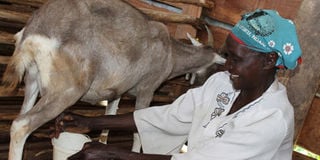You want to keep goats for milk? Then go for Toggs

Salome Emonyi Afandi milking her goat after feeding at the shed, Ekumu Village,Emuhaya in Vihiga county.Goats milk is on high demand in the region alleged to treat and prevent certain diseases in human body. PICTURES BY ISAAC WALE
What you need to know:
- The Toggenburg milk is highly nutritious with a butter content of 3.8 per cent as compared to the Alpine’s 3.5 per cent. The doe, under good management, can be served at eight months, an incredible attribute especially for women’s groups that distribute off springs in their numbers.
- They also have a twinning ability especially if reared under good management. Toggs have a relatively longer lactation period as compared to other dairy goats.
Dairy goats are considered the ‘‘poor man’s cows’’ due to the low-level of investment, both monetary and the time needed to manage the herd.
In rural areas, women are known to widely embrace goats just to ensure that they secure a cup of milk for their families. However, with the Toggenburg breed, their jugs can overflow with milk.
The Toggenburg, also known as Toggs, is an exotic breed that originated from Switzerland. Phenotypically, Toggenburgs are either brown, chocolate or fawn with a white line on either side of their faces from above the eyes to the muzzle, edges of ears, on the rump and the tail.
The legs are often white up to the knee. The hair is silky and the males have characteristically longer hair as compared to the females. The bucks also spot a pronounced beard. They exhibit a docile personality making them easier breeds to handle.
The Toggenburg buck can grow to up to 90cm in height and weigh up to 70kg while the doe can weigh up to 50kg and measure 79cm in height. Toggs are larger animals than the Alpine goat breeds.
This dairy breed has a commendable Daily Milk Yield (DMY) of an average of three litres and with improved management, it is known to hit the five litres per day mark.
This, compared to the local indigenous goat breeds, is an impressive milk production potential, as indigenous breeds produce about a litre (DMY) at their very best.
Milk is highly nutritious
The Toggenburg milk is highly nutritious with a butter content of 3.8 per cent as compared to the Alpine’s 3.5 per cent. The doe, under good management, can be served at eight months, an incredible attribute especially for women’s groups that distribute off springs in their numbers.
Kids at birth weigh an average of 3kg and can gain weight rapidly at approximately 137 grammes per day. Their gestation period is approximately five months and they do not have kidding problems.
They also have a twinning ability especially if reared under good management. Toggs have a relatively longer lactation period as compared to other dairy goats.
The Toggenburg is a relatively sensitive goat. It thrives best in cold areas unlike the Alpine or Saneen, which adapts well in semi-arid regions. The greatest challenge with the Toggs is that they require relatively higher maintenance to ensure optimal production.
Unlike their counterparts, the Toggenburg is not resilient to harsh conditions and diseases. Farmers who rear them experience a higher rate of mortality in instances where the housing conditions are not favourable.
However, with good feeds, husbandry and health management, the farmer can make very high returns from milk production. The success of a dairy goat farming enterprise lies in ensuring that the farmer has a good feeding and management programme. This should also include mineral supplements.
Dr Muchunguh is a livestock expert



